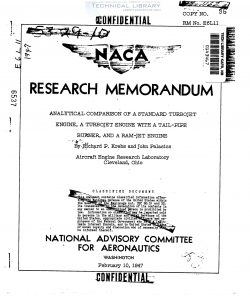naca-rm-e6l11
- Version
- 152 Downloads
- 1.02 MB File Size
- 1 File Count
- March 14, 2017 Create Date
- March 14, 2017 Last Updated
National Advisory Committe for Aeronautics, Research Memorandum - Analytical Comparison of a Standard Turbojet Engine, a Turbojet Engine with a Tail Pipe Burner, and a Ram-Jet Engine

The calculated performance of a standard turbojet engine, a
turboJet engine whose thrust is augmented by tail-pipe burning, and
a ram-Jet engine are compared. Computations for the performance of
the turbojet engines are based on an analytical extension of exper-
imental data obtained from an investigation of a turbojet engine
incorporating an ll—stage axial-flow compressor and a single-stage
impulse turbine in the altitude wind tunnel. The three types of
engine are considered to be operating at maximum output for any
given set of flight conditions.
The three engines-are compared on the basis of net thrust per
unit frontal area and specific fuel consumption at an altitude of
50,000 feet for flight Mach numbers up to 2.0. The effect of
changes in altitude from sea level to 40,000 feet were calculated
at Mach numbers of 1.2 and 1.6.
At static conditions, tail—pipe burning increased the net
thrust of the standard turbojet engine about 60 percent. At flight
speeds greater than the speed of sound, the net thrust was more than
doubled. Greatest percentage increases in net thrust with tail-pipe
burning could be obtained at low altitudes and high flight Mach
numbers. The net thrust per unit frontal area of the augmented
turboJet engine and the ram—Jet engine were equal at a flight Mach
number of 1.2. At this flight speed the ram Jet had a specific
fuel consumption based on net thrust approximately 45 percent
greater than the augmented turbojet.
Because of temperature limitations of the turbine, the fuel
burned in the combustion chamber of a turboJet engine is limited to
an amount corresponding to a mixture less than one—third stoichio«
metric. When additional fuel is burned in the tail pipe, the over-
all fuel-air ratio of'the engine may be raised to stoichiometric
and the thrust developed by the engine greatly augmented. Experi-
mental investigations (reference 1) have shown that in some cases
the thrust can be more than doubled by means of tail—pipe burning.
The effectiveness of tail-pipe burning is particularly good at high
flight speeds.
Operation with the tail- -pipe burner so increases the thrust of
the turboaet engine that it is comparable with that of a ram-Jet
engine at supersonic flight speeds. An evaluation of the thrust
per unit frontal area and specific fuel consumption of these two
propulsion systems has therefore been made.
| File | Action |
|---|---|
| naca-rm-e6l11 Analytical Comparison of a Standard Turbojet Engine, a Turbojet Engine with a Tail Pipe Burner, and a Ram-Jet Engine.pdf | Download |

Comment On This Post